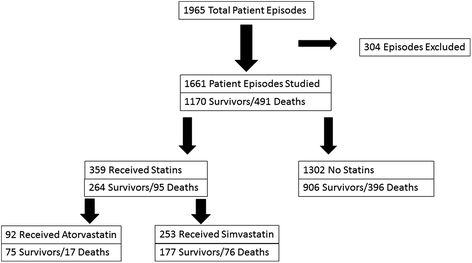Sepsis outcomes in patients receiving statins prior to hospitalization for sepsis: comparison of in-hospital mortality rates between patients who received atorvastatin and those who received simvastatin
- PMID: 25992302
- PMCID: PMC4430500
- DOI: 10.1186/s13613-015-0049-9
Sepsis outcomes in patients receiving statins prior to hospitalization for sepsis: comparison of in-hospital mortality rates between patients who received atorvastatin and those who received simvastatin
Abstract
Background: The purpose of this study is to compare the in-hospital mortality rates between septic patients receiving statins and those that did not prior to developing sepsis. We compared subgroups receiving atorvastatin and simvastatin because these two drugs differ in their pharmacologic properties.
Methods: This study was a retrospective analysis of patients selected from an institutional data base of patients hospitalized with sepsis. The study patients were drawn from a data base of 1,961 hospitalized patients with sepsis and included patients who met selection criteria and who were studied for HMG-CoA reductase inhibitor (statin) use both prior to and during hospitalization. The in-hospital mortality rates of patients receiving statins and those that did not prior to developing sepsis were compared. In-hospital mortality rates of patient subgroups receiving atorvastatin and simvastatin were also compared. A multivariable analysis was conducted with in-hospital mortality as the outcome variable and with multiple risk factors to include atorvastatin and simvastatin use.
Results: The mortality rate for 359 patients receiving statins prior to hospitalization for sepsis was not significantly different than that for 1,302 patients who did not receive pre-hospital statins (26.5% versus 30.4%, p > 0.05). The mortality rate for 92 patients who had received atorvastatin prior to hospitalization was significantly less than that of 253 patients who received simvastatin (18.5% versus 30.0%, p = 0.032). The use of atorvastatin prior to sepsis was independently associated with lower in-hospital mortality in a multivariable analysis of sepsis risk factors (p = 0.021, OR = 0.455). Patients who received atorvastatin prior to hospitalization for sepsis and had statins continued in hospital had a very low mortality rate that was significantly less than that of those patients who never received statins (15.7% versus 30.8%, p = 0.007).
Conclusions: Pre-hospital atorvastatin use was associated with improved in-hospital mortality in septic patients when compared with pre-hospital simvastatin use and was independently associated with an improved outcome when compared to other sepsis risk factors. The effect of statins in patients with sepsis may be different for individual statins.
Keywords: Atorvastatin; Critical illness; HMG-CoA reductase inhibitors; Inflammation; Mortality; Sepsis.
Figures


Similar articles
-
Incidence of Sepsis and Mortality With Prior Exposure of HMG-COA Reductase Inhibitors in a Surgical Intensive Care Population.Shock. 2016 Jan;45(1):10-5. doi: 10.1097/SHK.0000000000000484. Shock. 2016. PMID: 26674450
-
A Population-Based Cohort Study on the Drug-Specific Effect of Statins on Sepsis Outcome.Chest. 2018 Apr;153(4):805-815. doi: 10.1016/j.chest.2017.09.024. Epub 2017 Sep 27. Chest. 2018. PMID: 28962887
-
LDL-C goal attainment in patients who remain on atorvastatin or switch to equivalent or non-equivalent doses of simvastatin: a retrospective matched cohort study in clinical practice.Postgrad Med. 2010 Mar;122(2):16-24. doi: 10.3810/pgm.2010.03.2118. Postgrad Med. 2010. PMID: 20203452
-
Are statins created equal? Evidence from randomized trials of pravastatin, simvastatin, and atorvastatin for cardiovascular disease prevention.Am Heart J. 2006 Feb;151(2):273-81. doi: 10.1016/j.ahj.2005.04.003. Am Heart J. 2006. PMID: 16442888 Review.
-
Pharmacodynamics and pharmacokinetics of the HMG-CoA reductase inhibitors. Similarities and differences.Clin Pharmacokinet. 1997 May;32(5):403-25. doi: 10.2165/00003088-199732050-00005. Clin Pharmacokinet. 1997. PMID: 9160173 Review.
Cited by
-
Improved survival with continuation of statins in bacteremic patients.SAGE Open Med. 2018 Oct 21;6:2050312118801707. doi: 10.1177/2050312118801707. eCollection 2018. SAGE Open Med. 2018. PMID: 30364748 Free PMC article.
-
Immunosuppressive effects of circulating bile acids in human endotoxemia and septic shock: patients with liver failure are at risk.Crit Care. 2023 Sep 27;27(1):372. doi: 10.1186/s13054-023-04620-5. Crit Care. 2023. PMID: 37759239 Free PMC article.
-
Pregnane X receptor alleviates sepsis-induced liver injury through activation of yes-associated protein in mice.Acta Pharmacol Sin. 2025 Apr 15. doi: 10.1038/s41401-025-01552-4. Online ahead of print. Acta Pharmacol Sin. 2025. PMID: 40234620
-
Cytokine Storm in COVID-19-Immunopathological Mechanisms, Clinical Considerations, and Therapeutic Approaches: The REPROGRAM Consortium Position Paper.Front Immunol. 2020 Jul 10;11:1648. doi: 10.3389/fimmu.2020.01648. eCollection 2020. Front Immunol. 2020. PMID: 32754159 Free PMC article.
-
Cholesterol levels and long-term rates of community-acquired sepsis.Crit Care. 2016 Dec 23;20(1):408. doi: 10.1186/s13054-016-1579-8. Crit Care. 2016. PMID: 28010729 Free PMC article.
References
-
- Hall JH, Williams SN, DeFrances CJ, Golosinskiy A. Inpatient care for septicemia or sepsis: a challenge for patients and hospitals. NCHS Data Brief 2011; No. 62. Available at: http://www.cdc.gov/nchs/data/databriefs/db62.htm. Accessed December 2, 2014. - PubMed
LinkOut - more resources
Full Text Sources
Other Literature Sources
Miscellaneous

